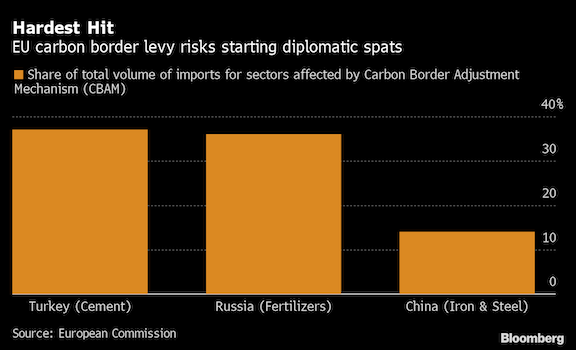The European Union wants to enact the world’s first pollution-import levy on global competitors. The details will take a while to hash out.
The measure, which will affect producers of steel, cement and aluminum in countries with looser environmental rules, would boost commodity costs and reroute trade flows. But it will take years to implement and have a limited impact on global emissions. Experts are already warning that the Carbon Border Adjustment Mechanism will be a nightmare to put in place.
1. Why is the EU doing this?
Europe wants to cut its emissions by 55% by 2030 on the way to net-zero by mid-century. To do that, energy-intensive industries are being charged for polluting. Now the bloc wants its foreign rivals to pay too to keep a level playing field and stop domestic producers from being undercut.
“As long as industrial installations outside the EU are not subject to similar ambitious measures, these efforts can lose their effect,” said Paolo Gentiloni, the European Commissioner for Economy.
It still needs approval from national governments and the European Parliament—giving companies plenty of time to lobby.
2. When will it come into effect?
The measure is expected to be implemented in two phases. From 2023 to 2025, the EU will monitor the information companies report on their emissions. Only after that will a levy at the border start to apply in 2026.
A phase-in period would allow firms to calculate their footprint, a condition for the measure to comply with World Trade Organization rules. Still, putting theory into practice may prove hard.
“Implementation could prove to be a logistical nightmare,” said James Whiteside, global head of multi-commodity research at Wood Mackenzie. “There is little transparency around carbon emissions associated with products. Determining the country of origin of products can also be problematic.”
3. Does it help the planet?
The new levy is likely to do very little to curb greenhouse gas emissions. With a carbon border adjustment of $44 a metric ton, a United Nations body estimates emissions would only fall by 27 million tons, a meager 0.1% of the total. At $88, it would drop by 45 million tons. The price of carbon in the EU is currently about 53 euros ($62) a ton.
The estimates are mirrored by German think tank Bertelsmann Stiftung, which said it would only lead to an extra 0.2 percentage points reduction in the amount of CO2 discharged into the atmosphere globally. A more ambitious alternative would be a global minimum carbon price—but that’s seen as even harder to pull off.
“The effects on the environment are rather, rather small,” said Thomas Rausch, a senior project manager at Bertelsmann. “It is important that you employ carbon pricing on a global level.”
4. What type of emissions count?
For all the hype about the new tariff, the EU chose to require companies to report in the first phase only the pollution that comes directly from their operations, the so-called scope 1 emissions. That means firms are off the hook for much broader emissions connected to their products.
“The limitation to scope 1 is disappointing vs expectations, but may be reviewed to scope 2 from 2025,” Morgan Stanley analysts said in a report.

5. What does it mean for steel producers?
Russian steel producers, whose blast furnaces pollute slightly more than their European counterparts, will be the hardest hit. Still, it’s not likely to be punitive at least initially given the low cost of Russian production and the slow phase-in. It may give producers like Severstal PJSC and Novolipetsk Steel PJSC a financial incentive to improve their emissions profiles if they want to keep shipping to their biggest export market.
Turkey, the biggest exporter of steel to Europe, may actually gain an edge under the new system. It’s still to be decided if indirect emissions from power usage will be covered by CBAM, meaning the Turkish industry—which heavily uses furnaces that emit solely through their electricity usage—will be less affected.
6. How does it hurt aluminum producers?
Analysts expect the levy to create an additional premium for metal produced using green energy, while major Russian producer United Co. Rusal says the measure is set to fuel a rise in aluminum prices globally.
European consumers are heavily reliant on imports, and imposing the levy could accelerate a scramble for green aluminum that’s currently in short supply. Still, critics of the measure argue that it may prove ineffective in pushing producers outside the bloc to go green.
The proposal “will not contribute to reducing global CO2 emissions across our sector, but will accelerate the investment and employment leakage trend European industries have experienced over the past decades,” said Gerd Gotz, Director General of industry association European Aluminium.
7. Will the EU end up in court?
The EU’s levy would apply to steel, cement, aluminum, fertilizer and electricity, and is likely to upend trade and become a new source of international tension. Turkey, Russia and China are among the most affected countries and may choose to dispute the measure as anti-competitive in the WTO. The EU says it’s in line with international trade rules, and points out that it targets products, not countries.
“The Commission has really good lawyers,” said Oliver Sartor, senior adviser at the Agora Energiewende think-tank. “Provided they designed the CBAM in a way that doesn’t include export rebates and is not discriminatory between domestic and imported product—the CBAM would by and large be considered WTO-compatible.”











